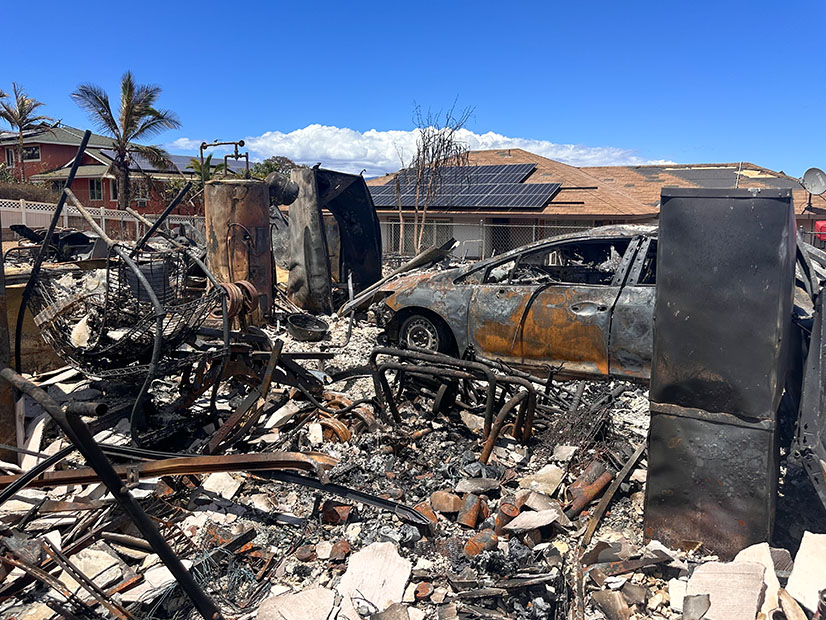
Hawaiian Electric Co. (HECO) and its parent company Hawaiian Electric Industries have agreed to pay $1.99 billion to settle all claims against them for last year’s wildfires on Maui, the companies announced Aug. 2.
HECO’s payment comprises a bit less than half of a global settlement involving the two companies and six other defendants — the state of Hawaii, Maui County, Kamehameha Schools, West Maui Land Co., Hawaiian Telcom and Spectrum/Charter Communications — totaling $4.037 billion. Maui County said in a statement the settlement was negotiated by mediators “appointed by the court overseeing most of the Maui wildfire lawsuits.”
The agreement also would settle all claims between the defendants, HECO said in its announcement. Maui County, one of the defendants in the global settlement, also is among the plaintiffs that sued HECO following the fires.
“Achieving this resolution will allow all parties to move forward without the added challenges and divisiveness of the litigation process. It will allow all of us to work together more cohesively and effectively to support the people of Lahaina and Maui to create the future they want to see emerge from this tragedy,” HECO CEO Shelee Kimura said. “For the many affected parties to work with such commitment and focus to reach resolution in a uniquely complex case is a powerful demonstration of how Hawaii comes together in times of crisis.”
HECO’s payout includes $75 million that the utility already contributed to the One Ohana Fund, created last year to compensate victims of the wildfires and their families for “deaths and serious physical injuries.” The fund pays $1.5 million to the families of each deceased victim and determines compensation for physical injuries on a case-by-case basis.
Hawaii Gov. Josh Green said in a separate statement that the proposed settlement, described as an agreement in principle, will resolve the claims of about 2,200 affected parties who have filed lawsuits against one or more of the co-defendants. Green said he was grateful the agreement had been worked out after about four months of mediation, as opposed to a lawsuit like those over wildfires in other states that “typically take years to adjudicate.” The agreement has not received final approval from the court.
“My priority as governor was to expedite the agreement and to avoid protracted and painful lawsuits so as many resources as possible would go to those affected by the wildfires as quickly as possible,” Green said. “It will be good that our people don’t have to wait to rebuild their lives as long as others have in many places that have suffered similar tragedies.”
Green added that the state’s contribution to the settlement must be approved by the legislature. Once this has been completed and the court has signed off, the payments are expected to begin by the middle of 2025.
Last year’s wildfires killed 100 people and burned more than 3,000 acres on Maui, including the historic town of Lahaina. HECO faced widespread criticism in the immediate aftermath, with lawsuits filed by multiple plaintiffs alleging that the utility failed to power down electric equipment even amid fire danger warnings from the National Weather Service; did not properly maintain and repair utility poles; and neglected to keep vegetation trimmed and away from power lines. (See Hawaiian Electric Faces Multiple Lawsuits over Wildfires.)
Testifying before Congress last year, Kimura defended her company against allegations of responsibility for the fires, noting that the lines in the area where the Lahaina fire began Aug. 8 were not energized at the time. (See House E&C Members Grill HECO CEO About Maui Fires.) HECO did not have a pre-emptive public safety power shutoff program in place at the time the wildfires began, but Kimura said the utility was considering implementing one; it introduced its first PSPS program last month on Oahu, Hawaii Island and Maui.
In addition, the Hawaii Public Utilities Commission on Feb. 1 approved HECO’s five-year resilience plan to harden the grid against future wildfires and other natural disasters. Steps in the plan include replacing or strengthening more than 2,000 transmission poles on critical circuits, installing cameras and sensors to increase situational awareness in areas with higher wildfire risk, removing trees that are in danger of falling on power lines and undergrounding selected distribution circuits.



